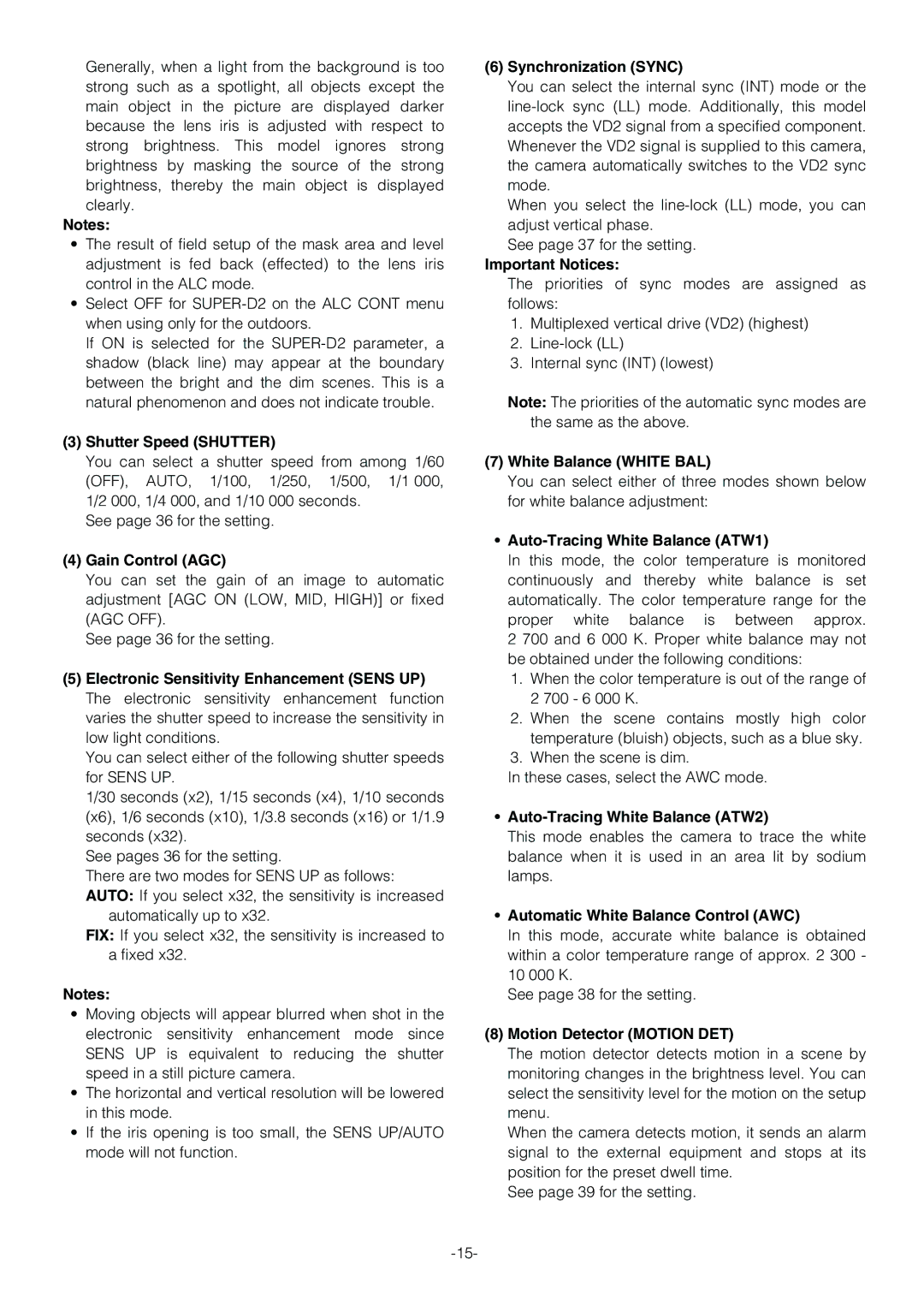Generally, when a light from the background is too strong such as a spotlight, all objects except the main object in the picture are displayed darker because the lens iris is adjusted with respect to strong brightness. This model ignores strong brightness by masking the source of the strong brightness, thereby the main object is displayed clearly.
Notes:
•The result of field setup of the mask area and level adjustment is fed back (effected) to the lens iris control in the ALC mode.
•Select OFF for
If ON is selected for the
(3) Shutter Speed (SHUTTER)
You can select a shutter speed from among 1/60 (OFF), AUTO, 1/100, 1/250, 1/500, 1/1 000, 1/2 000, 1/4 000, and 1/10 000 seconds.
See page 36 for the setting.
(4)Gain Control (AGC)
You can set the gain of an image to automatic adjustment [AGC ON (LOW, MID, HIGH)] or fixed (AGC OFF).
See page 36 for the setting.
(5)Electronic Sensitivity Enhancement (SENS UP) The electronic sensitivity enhancement function varies the shutter speed to increase the sensitivity in low light conditions.
You can select either of the following shutter speeds for SENS UP.
1/30 seconds (x2), 1/15 seconds (x4), 1/10 seconds (x6), 1/6 seconds (x10), 1/3.8 seconds (x16) or 1/1.9 seconds (x32).
See pages 36 for the setting.
There are two modes for SENS UP as follows: AUTO: If you select x32, the sensitivity is increased
automatically up to x32.
FIX: If you select x32, the sensitivity is increased to a fixed x32.
Notes:
•Moving objects will appear blurred when shot in the electronic sensitivity enhancement mode since SENS UP is equivalent to reducing the shutter speed in a still picture camera.
•The horizontal and vertical resolution will be lowered in this mode.
•If the iris opening is too small, the SENS UP/AUTO mode will not function.
(6)Synchronization (SYNC)
You can select the internal sync (INT) mode or the
When you select the
See page 37 for the setting.
Important Notices:
The priorities of sync modes are assigned as follows:
1.Multiplexed vertical drive (VD2) (highest)
2.
3.Internal sync (INT) (lowest)
Note: The priorities of the automatic sync modes are the same as the above.
(7)White Balance (WHITE BAL)
You can select either of three modes shown below for white balance adjustment:
•Auto-Tracing White Balance (ATW1)
In this mode, the color temperature is monitored continuously and thereby white balance is set automatically. The color temperature range for the proper white balance is between approx. 2 700 and 6 000 K. Proper white balance may not be obtained under the following conditions:
1.When the color temperature is out of the range of 2 700 - 6 000 K.
2.When the scene contains mostly high color temperature (bluish) objects, such as a blue sky.
3.When the scene is dim.
In these cases, select the AWC mode.
•Auto-Tracing White Balance (ATW2)
This mode enables the camera to trace the white balance when it is used in an area lit by sodium lamps.
•Automatic White Balance Control (AWC)
In this mode, accurate white balance is obtained within a color temperature range of approx. 2 300 - 10 000 K.
See page 38 for the setting.
(8)Motion Detector (MOTION DET)
The motion detector detects motion in a scene by monitoring changes in the brightness level. You can select the sensitivity level for the motion on the setup menu.
When the camera detects motion, it sends an alarm signal to the external equipment and stops at its position for the preset dwell time.
See page 39 for the setting.
